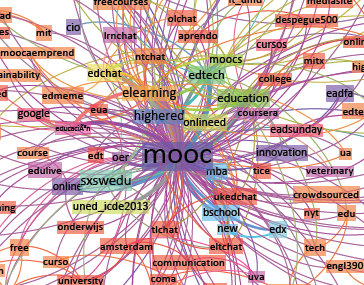Thinking of MOOCs from the connectivist perspective. In my opinion, this is this way of using a MOOC is the ONLY mode that has the possibility of offering a successful format for humanities. These social media can be used by any kind of subject, but if all schools are jumping on this bandwagon (and with a n xMOOC model in mind primarily), it is crucial that arts & humanities folks learn how make the most of social media. I would suggest that for a philosophy class, instructors will need to become very familiar with Twitter as well as Skype or Google Video. But again, here comes the labor intensity issue: This requires that folks doing MOOCs are primarily teachers not researchers. They need to give their time over to the classes to be a real resource if true connections are going to be encouraged. Students can learn for themselves in many areas. But there will never be a replacement for learning dialog & communication skills by actually having dialogs and communications with people who have decades of experience.
Related articles
- Three Horsemen of the MOOCapolypse (keithwaynebrown.com)
- Researchers want to know who is taking MOOCs and why so many are dropping out (Photos) (examiner.com)
- The Four Student Archetypes Emerging in MOOCs (mfeldstein.com)
- Friday Reads: “Stop Lurking. Start Participating” by Susan Murphy (criticalmargins.com)
- Good MOOC’s, Bad MOOC’s (virtuallyeducation.wordpress.com)
- When the student is ready, the teacher will appear #edcmooc (mymoocadventure.wordpress.com)
Social media and digital learning environments are now combined. As part of the MOOC experience, students are requested to join debates and course’s topics on social networks, such as Facebook, Twitter or Google +. The idea is to go beyond the regular e-learning platform, or the virtual class – instructors want to encourage students to learn and share ideas where they feel most comfortable at. I believe this is a great thing about MOOCs. Not only we can learn everywhere, but it is also easier to be in touch professionals/students with similar interests. Have you ever, for example, joined a Facebook Group of a MOOC class? It is amazing what people can share out there.
View original post 718 more words




One comment